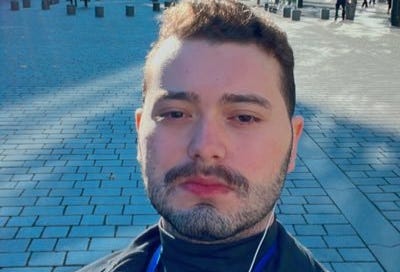Today I have the pleasure of interviewing Brazilian investor Gerson Brilhante.
From January 2021 to March 2025 his historic performance will be the envy of anyone.
His portfolio returned more than 205.4% in the period, versus 17.6% for Ibovespa.
He multiplied the invested capital by 3x!
This guy knows how to generate real value.
Shall we meet him?
BS: Gerson, could you tell us a little about yourself?
GB: I'm 21 years old, but I started investing when I was 14, living in the countryside of São Paulo. From a very young age (12, 13 years old) I was interested in philosophy and literature, which helped me a lot in my process as an investor. Today, I'm responsible for the entire international equity side of Levante Corp, one of the largest analysis houses in Brazil.
BS: Why have philosophy and literature helped you so much in investing?
GB: Philosophy gives me the logical framework, while literature gives me the human data to fill that framework. Together, they help me avoid biases like overconfidence, common among those who ignore history or human complexity.
Philosophy, in an epistemological sense, has taught me to question what I know and how I know it. In investing, this means not accepting data or market trends as absolute truths.
Stoic philosophy, on the other hand, helps me stay calm during market crashes. Instead of reacting impulsively to volatility, I focus on what I control: my strategy, not the collective panic. This prevents rash selling and buying out of euphoria.
Works like Shakespeare's Macbeth reveal to me the emotions: greed, fear, guilt, that drive people. In the market, understanding these is crucial to predicting market behavior. The tulip bubble of the 17th century or the crash of 1929 were driven by these same emotions, which literature helped me recognize.
Literature also trained me to spot stories that repeat themselves. For example, in The Great Gatsby, I see excess and the illusion of easy wealth, a parallel to the hype of cryptocurrencies or meme stocks like GameStop in 2021. Recognizing these patterns allows me to anticipate when enthusiasm might be inflating an asset beyond its true value.
While the numbers tell me what’s happening, these disciplines show me why and what might come next. For someone in the investment world, this is like having a map where others only see disconnected dots.
BS: What is your strategy for making money on the stock market?
GB: Valuation and flow. I really like operating these two models. It doesn't make much sense to me, if you need to generate alpha in the short term, to only buy companies that are worth more than the screen price, if there is no flow. The opposite is also true, there is no point in buying anything at any price just because the flow is positive. In short, I like to look at valuation and macro.
BS: What is your process for finding a new buy opportunity? What filters do you use?
GB: It really depends. At the end of 2023, I went to Prague, in the Czech Republic. I noticed a city that looked like it had just suffered an earthquake, with lots of buildings. I thought to myself, “There must be some bank financing this.” That’s when I bought a Czech bank called Moneta Money, which has gone up 100% since then.
But of course, there’s the checklist filter that everyone uses: P/E, ROIC, EV/EBITDA, P/B, etc. ROIC > Ke is the most important metric in my view.
BS: How do you value a share: DCF, Multiples, implied IRR, a mix of the previous ones, …?
GB: I don't have a philosophy. Philosophy presupposes idealization, but the market was not made to be idealized. I believe that the market was not made to be projected. The market was made to be anticipated and interpreted, and if you do this before everyone else, you are rewarded. I say this because I place a lot of emphasis on reverse DCF, but I also use the traditional DCF, IRR and multiple models.
BS: How do you like to build your stock portfolio, considering the number of companies, sectors and concentration?
GB: I like to have exposure to all the countries in the world that I have access to, from Brazil to Malaysia. But I usually have a much heavier presence abroad; Brazil rarely makes up more than 30% of my portfolio. I don't like to have an exact number of assets, because I invest all over the world, and something interesting is always popping up. Today, my portfolio must be around 50 stocks.
BS: How often do you like to rebalance your portfolio?
GB: It depends a lot on the moment. If I see an asset gaining a lot of weight and I don't see much future in it anymore, I gradually reduce it and then there is the rebalancing, but I don't work with specific dates.
BS: How long on average do you hold a position in your portfolio?
GB: Again, it really depends on the timing. Sometimes 1 month, sometimes 1 year, sometimes 3 years, it's all about price and flow.
BS: Do you believe that graphical analysis, together with fundamental analysis, can help with the buying and selling points of stocks?
GB: I like to use graphical analysis to see how some macro/sector ideas are flowing. I find it useful, but my decision is 100% based on fundamental analysis.
BS: Do you use derivatives? What is your strategy?
GB: Hardly ever. Sometimes I open a short position on something that I think is extremely overpriced. But it's around 5 trades a year at most.
BS: Do you use a stop? Where do you usually place it?
GB: I've never used it.
BS: What is the cheapest company on the stock market today?





